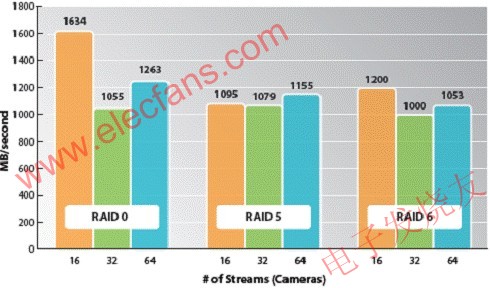Video surveillance storage system and RAID level application analysis
Over the years, as analog content has gradually transitioned to digital content, new video surveillance application models have emerged. Enterprise security and information technology teams need to work together to design solutions that meet more complex requirements. As an example, while approximately 95% of video surveillance I/O operations are write operations, most enterprise storage systems are designed to speed up reads, which are often subject to data protection.
This article refers to the address: http://
Write applications differ from traditional read/write systems in terms of specifications. First, the degree of risk associated with video clip loss is the most important determinant of such storage application customers. Other factors that need to be addressed include storage capacity, resolution, and data protection.
The choice of which RAID level to choose depends largely on the ultimate priority of the above factors. In order to get the best storage solution, we need a comprehensive understanding of which level the customer belongs to and the size of the budget available.
  

Source: Pelco Technical White Paper: Improving the Reliability of Video Surveillance Storage Systems While Reducing Costs
High-end application
High-end applications need to run around the clock. Due to the high risk of video clip loss, organizations using high-end applications (airports, prisons, etc.) often need to meet strict specifications to ensure that the data is intact. Because storage data at the PB level (rather than the GB level) is often required for long periods of time, large storage capacity requirements are critical. The number of video streams is also high, for example, a system with 100 cameras can generate more than 30 TB of data per week. High-end applications usually require the highest possible resolution, so the bit rate is also higher. In addition, since content is difficult to copy once it is lost, it is important to protect hard disk data regardless of cost. Another factor to consider in this type of environment is that the storage system must be able to hold the video stream in any array, including ensuring minimum performance levels in degraded mode or during rebuild.
RAID 6 is the best choice for 24/7 operation, providing dual parity protection for dual drive failures and allowing administrators enough time to replace failed drives before data is corrupted.
Mid-end application
For organizations that use mid-range applications (companies, schools, etc.), the risk associated with video stream capture failures is relatively low, but there is still a high capacity requirement to meet the requirements for on-demand archiving and reference video clips. Data quality requirements may vary, some may require higher resolution, while others only need to meet lower video quality. Avoiding data protection and drive failures is still very important, but the difference with high-end applications is that mid-range applications can accept a small amount of frame loss when rebuilding the array. Of course, this phenomenon should be avoided.
If archiving requirements need to support high data availability, RAID 6 will be the best choice for customers. RAID 5 is more applicable if the customer has enough IT staff on site to replace the drive, or does not necessarily have to ensure long-term 24/7 operation, which helps to achieve higher net storage capacity than RAID 6.
Low-end application
The low-end products are mainly concerned with cost issues, even if the frame loss is not too much risk, and can allow rewriting every day, so the capacity requirements are lower. Organizations that use such low-end applications (retailers, small offices, etc.) can use lower resolution images, and there is no need to care about data protection when the drive fails.
RAID 0 is the lowest cost RAID level, delivering the highest performance with the fewest number of drives and providing the system with maximum net storage capacity. However, if one of your drives fails, using RAID 0 will result in data loss. If your customers need data protection and their budget is tight, consider using other levels such as RAID 10 or 5.
Choose the appropriate RAID level
Based on the above analysis, we can see that high-end applications need to ensure 24/7 operation, and RAID 6 is the best RAID technology to meet this high availability requirement. The specification requirements for mid-range applications vary, so RAID 5 is usually a good choice. For most cost-sensitive low-end applications, RAID 0 is an appropriate choice for us to consider, especially if we allow daily rewrites. If you need data protection technology, you can choose between RAID 5 and 10.

Â
LSI 6Gb/s SATA+SAS configuration and test results
To help users select the components of the customer video surveillance application, LSI is configured and tested to demonstrate how to achieve the desired level of performance for users to consider when considering storage solutions.
System Configuration
• Supermicro X8DTL-6F server
• Dual Xeon CPU
• 2x2GB DRAM
• Microsoft Windows Server 2003 Enterprise Edition, Service Pack 2
• LSI 3ware 9750-8E (drive version is 5.01.00.016, firmware version is FH9X 5.12.00.006)
• LSI 620J is connected to two x4 multi-line cables (with 6Gb expander backplane)
• 24 Seagate 6Gb SAS drives (Model: ST973352SS)
Test configuration
• Each worker queue depth using IOmeter is 1
• 256 KB strips
• 100% sequential writes
• Write cache supports best results for each RAID type (WT/WB)
• RAID 0, RAID 5, RAID 6
• 2 minutes running time
• ramp up time 30 seconds
  

The OREMA Marine/RV battery is an outstanding product in our range that consistently outperform traditional flooded, AGM batteries, and Gel batteries. They offer remarkable dual-purpose functionality, as they can provide both high energy for short-term starting and consistent power for longer-term cycling, making them versatile for various applications.
When it comes to starting performance, OREMA Marine/RV batteries excel by providing a high burst of current needed to start a vehicle's engine. This superior starting performance, even in harsh and demanding conditions, is a testament to their quality, reliability, and efficiency.
In terms of cycling performance, these batteries demonstrate exceptional ability. A battery's cycling performance refers to its capacity to go through multiple charge and discharge cycles without losing its ability to hold a charge. OREMA Marine/RV batteries, in this context, excel by retaining their capacity to hold and deliver power effectively even after numerous cycles. This superior cycling performance allows these batteries to deliver reliable power over a more extended period, making them ideal for applications that require consistent power delivery.
What sets OREMA Marine/RV batteries apart is their exceptional tolerance of a wide ambient temperature range. They remain unfazed and efficient, whether in scorching summer heat or freezing winter conditions. This temperature resilience makes them suitable for use in various climates and conditions, thereby ensuring uninterrupted and reliable performance no matter the weather.
Further bolstering their versatility and robustness is their high resistance to vibration. This is a vital feature in the boating, caravanning, and trucking world, where constant movement and bumps are part and parcel of the journey. Their vibration resistance ensures they can withstand such conditions and continue to operate optimally, making them a reliable power source in these challenging environments.
Another noteworthy feature is their capacity for Partial State of Charge (PSOC) operation. Unlike many traditional batteries that require full charging and discharging cycles, OREMA Marine/RV batteries can operate effectively even when partially charged. This flexibility means they can deliver power as needed, even if they haven't been fully charged, making them ideal for scenarios where full charging might not be possible.
OREMA Marine/RV batteries are versatile, as they are extensively used for a range of applications including Marine, Caravan, Boat, and Truck. This broad use-case potential further demonstrates their adaptability and efficiency. Their high performance in various vehicles and environments, their resilience in diverse weather conditions, and their ability to deliver power effectively irrespective of the charge level make them a superior choice for a wide range of applications.
The OREMA Marine/RV batteries stand as a testament to innovation, providing superior dual-purpose, starting, and cycling performance compared to traditional flooded, AGM, and Gel batteries. Their resilience against a wide range of ambient temperatures, vibrations, and ability to operate in a Partial State of Charge, combined with their broad use in Marine, Caravans, Boats, and Trucks, mark them as a remarkable choice in the realm of power solutions.
Marine/RV Battery,AGM Marine/RV Battery,EFB Marine/RV Battery,Truck Battery
OREMA POWER CO., LTD. , https://www.oremabattery.com